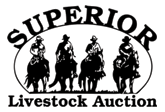Superior Livestock Auction data shows weaning calves yield premiums for producers
Recent analysis of Superior Livestock Auction’s video data, as reported by Kansas State University researchers, has provided insight to the long debated value of weaning and preconditioning programs.
Over the past few years, calf prices have declined and reduced profits have provided motivation for understanding the benefits of adding value to calves. Data from Superior Livestock Auction shows that calf buyers will pay premiums for calves that have been weaned at least 45 days, even after accounting for differences in preconditioning programs. These results are ever important as ranchers strive to increase profits while managing input costs.
The study evaluated 7,358 sale lots, totaling 743,158 calves, which were classified by vaccination and weaning protocols as defined by the well-known VAC24, VAC34, VAC34+, VAC45 AND VAC45+ programs. Calves were also classified as “weaned and received a viral vaccination at some time” and “non-weaned and received a viral vaccination at some time.”
Results indicated that at an average calf weight of 574 pounds, weaning was worth an extra $4 to $7 per hundredweight, or $20 to $40 per head, without giving consideration for any weight gain during the weaning period. These results are supported by data from Oklahoma Quality Beef Network that showed weaned calves bring 1.5 to 3 percent higher prices than non-weaned calves.
Dr. David Lalman, Oklahoma State University Extension beef cattle specialist, stated, “The OQBN is a mechanism that builds trust between buyers and sellers. The program encourages producers to use effective pre-weaning and weaning management practices that alleviate stress and disease risk.”
Lalman continued, “Value is added through improved prices, but don’t overlook the added value of weight gain during the 45-day or longer growing period. Producers that achieve a nutritionally balanced, economical ration during this period can add considerably more value to their calf crop.”
Further supporting these results are feedlot operators, who are not fans of receiving bawling calves. Jerry Jackson, manager of Stampede Feeders in Scott City, Kansas, said that the added stress of sudden separation from their mothers significantly affects performance and health.
“When calves arrive at the feedlot that have not been weaned for 45 days, or preferably 60 days, we face some difficult situations,” Jackson said. “The stress contributes to a breakdown in immune system function, so even if the proper vaccines have been administered—if enough time has not been allowed for the calf to build actual immunity to the respiratory diseases—it can be a wreck.”
Weaning calves can pay big dividends. Buyers are assured of healthier calves that can get started on feed earlier, and they will pay more for them. Ranchers, in turn, will receive a greater return for their efforts in both money and time invested.
The bottom line is weaned calves are typically worth $20 to $40 more per head than otherwise equal non-weaned calves, before accounting for weight gain during the weaning period. These results, combined with vaccination protocols, can help producers send more profitable calves to the marketplace.

